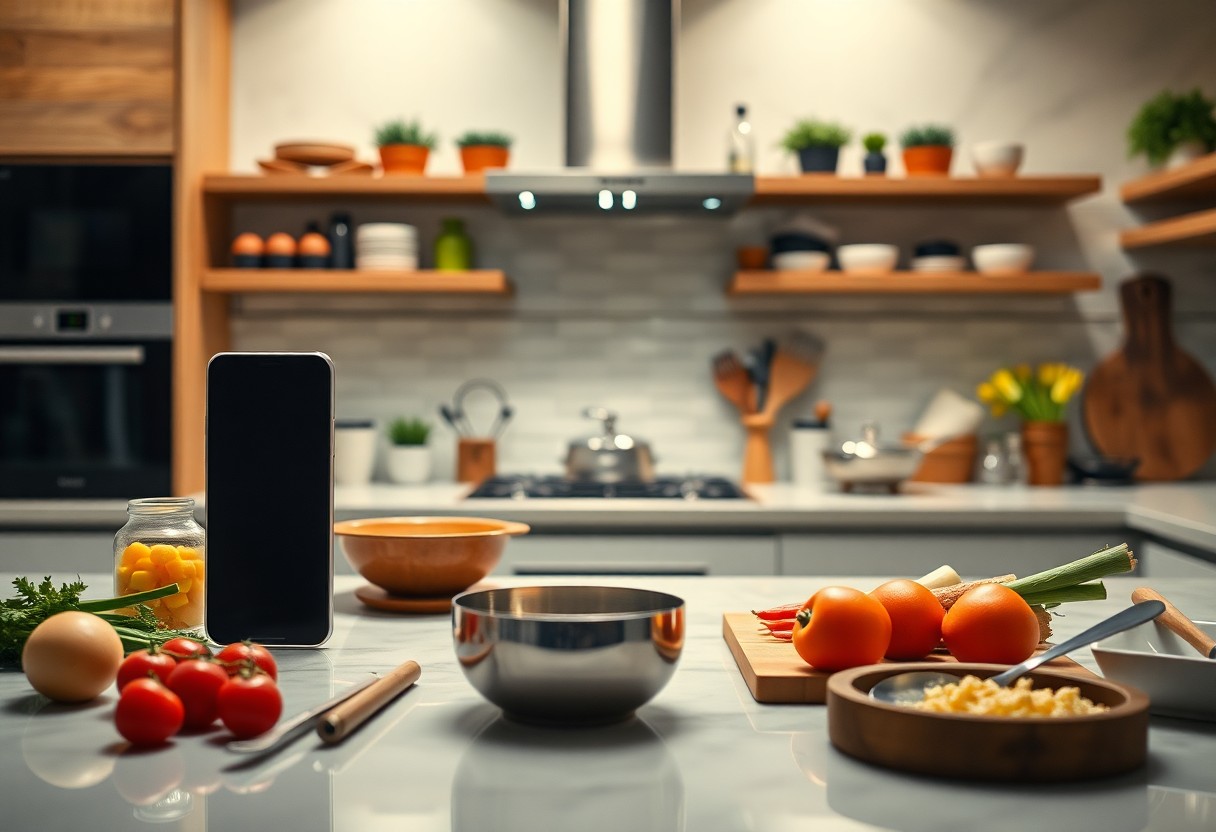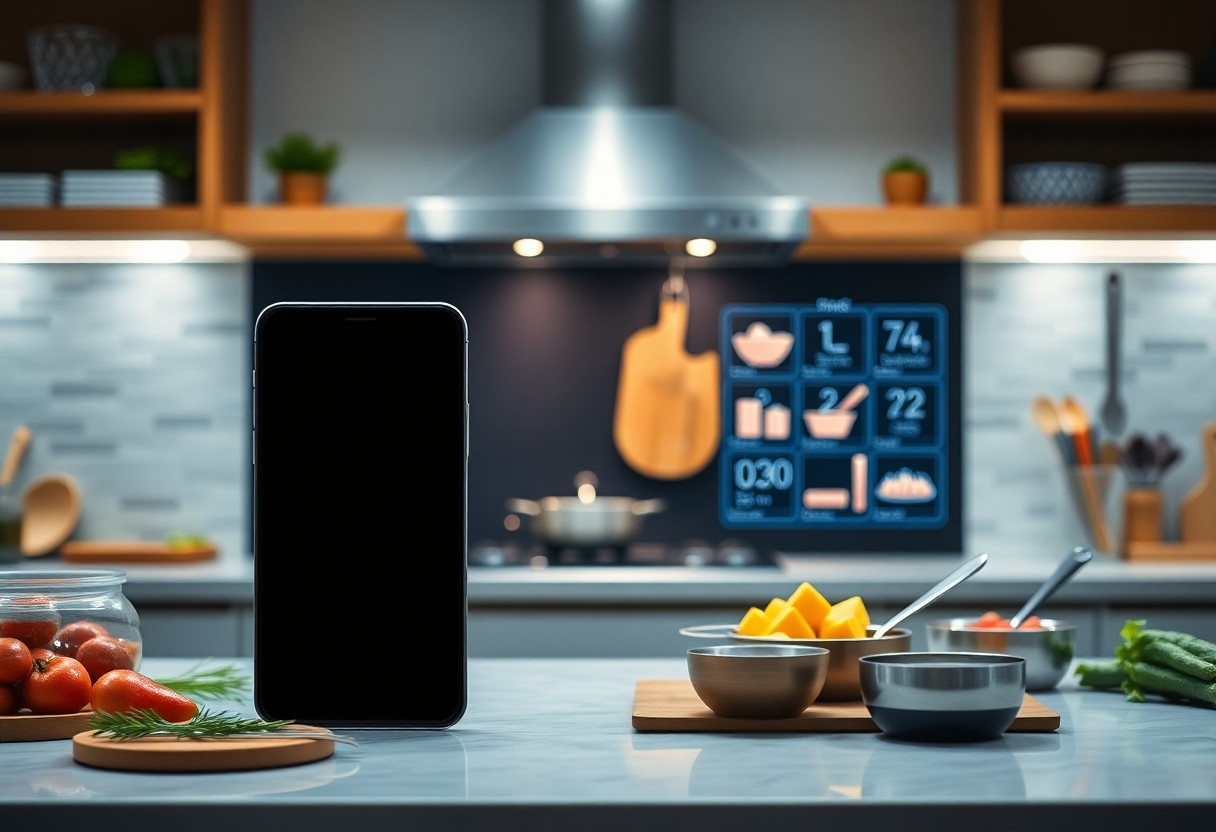Cooking can be a fun and rewarding experience, but having the right tools at your fingertips is crucial. You may find yourself torn between using your smartphone or investing in a smart kitchen display for recipes and instructions. Each option has its benefits and drawbacks that can impact your culinary success. In this post, you’ll discover the advantages of each method, helping you make an informed choice on which device will enhance your cooking experience while ensuring safety and efficiency in the kitchen.
Key Takeaways:
- Smart kitchen displays offer a larger touch interface and can be positioned at eye level, making it easier to follow recipes and view cooking videos while hands-free.
- Smartphones provide portability, allowing you to easily move around the kitchen, but might require frequent cleaning or protection from spills and messes.
- Integration with smart home devices varies, with kitchen displays often featuring seamless compatibility for managing other appliances, while smartphones rely on app availability.

The Functional Duel: Smartphone Utilities in the Kitchen
Smartphones have become indispensable tools in the kitchen, providing a wealth of resources and interactive features at your fingertips. The convenience of accessing recipe apps, meal planning tools, and nutritional information can’t be overstated. You can follow step-by-step instructions from your favorite chefs or watch cooking tutorials while you chop, sauté, or bake, minimizing guesswork and maximizing fun. Plus, the ability to set timers, create grocery lists, and receive notifications ensures that you’ll stay organized and on track while whipping up your culinary creations.
App Variety and Custom Recipes
The expansive array of cooking apps available on your smartphone takes meal prep to a whole new level. From recipe organizers like Paprika to comprehensive meal planning tools like Whisk, you can curate a digital library filled with custom recipes tailored to your taste and dietary needs. Many apps also allow you to input your specific ingredients, enabling you to create recipes that use what you already have on hand, reducing waste and saving money.
ChatGPT and Voice Assistants Enhancing Cooking
Integrating ChatGPT and voice assistants into your cooking routine can significantly enhance your kitchen experience. By simply using voice commands, you can access tips, ingredient substitutions, or cooking techniques without ever touching your phone. Whether you need to adjust timers, look up cooking times, or ask for ideas based on the ingredients you have, these AI tools can provide instant assistance, allowing you to focus on the cooking process itself.
Voice assistants can also handle your multitasking with ease, providing a hands-free way to follow recipes or retrieve information. For example, if you find yourself uncertain about the right temperature for roasting chicken, just ask your voice assistant – it will deliver the answer immediately so you can remain focused on your meal. Integrating AI into your cooking workflow streamlines the process, making it easier for both novice and seasoned cooks to experiment and succeed in the kitchen.
Smart Kitchen Displays: The All-in-One Kitchen Command Center
Smart kitchen displays serve as your comprehensive solution for cooking tasks, unifying numerous functionalities into one device. With their ability to display recipes, manage timers, and play music, these screens transform your cooking experience into a streamlined process. Their hands-free voice commands allow you to seamlessly navigate through recipes or adjust settings without needing to touch the display, making it easier to keep your hands clean and focus on your culinary creations.
Screen Size and Visual Engagement
The screen size of smart kitchen displays significantly enhances your cooking experience. Larger screens allow for clear visibility of recipes, enabling you to easily follow along without squinting or stepping away from your workstation. A vibrant, high-resolution display can also showcase step-by-step visuals, making complex techniques feel more approachable and engaging.
Integration with Smart Appliances
Integration with smart appliances showcases the true potential of smart kitchen displays. These devices can connect with various kitchen tools, from smart ovens to connected refrigerators, enabling you to control temperature settings, monitor cooking times, and manage grocery lists all from one interface. Devices like the Samsung Smart Fridge can share ingredient information, while smart ovens from brands like June or Tovala allow for automatic cooking adjustments based on the recipes displayed on your screen. This interconnectedness means you can optimize meal prep, reduce energy consumption, and even enable remote management of your kitchen tasks, revolutionizing the way you cook.
Hands-Free Advantage: The Benefits of Voice Activation
Voice activation transforms your cooking experience, allowing you to interact with your devices without lifting a finger. This hands-free capability is especially beneficial when you’re dealing with messy ingredients or handling hot pots. With a simple command, you can search for recipes, set timers, or control appliances, all while keeping your focus on the meal at hand.
Ease of Use While Cooking
Cooking often requires multitasking, and voice activation simplifies this process. Instead of stopping to wipe your hands on a towel to handle your device, you can just speak. For instance, asking your smart display for ingredient measurements or turning up the heat on your oven becomes seamless, saving you time and ensuring continuity in your cooking flow.
Accessibility for All Skill Levels
Voice-activated technology caters to various skill levels, making cooking more accessible. Novice cooks can easily follow step-by-step instructions, while experienced chefs can quickly adjust settings without interruption. Voice commands eliminate the intimidation often felt with complex recipes, allowing everyone to enjoy the process of cooking, regardless of their expertise.
The accessibility of voice-activated devices encourages a broader range of users to engage with cooking. For beginners, simple phrases like “How do I boil an egg?” enable hands-on learning without the worry of losing track of a recipe. More experienced cooks appreciate the ability to ask inquiries like “How long until my timer goes off?” or “What’s the temperature for roasting vegetables?” seamlessly. This technology fosters confidence, encourages exploration, and creates an engaging environment for all cooks, helping you to grow and learn in the kitchen, no matter your existing skills.
Connectivity and Updates: Which Provides Better Support?
Connectivity is key for accessing recipes and cooking tips in real-time. Smart kitchen displays often provide a seamless, cloud-based connection for updates and integration with other kitchen devices. This means you can continually access the latest content, including new recipes and cooking methods. For insights into how these devices may impact your cooking skills, check out this article on Can smart kitchen devices actually make you a better cook?.
Cloud-Based Features of Kitchen Displays
Smart kitchen displays often sport cloud-based features that allow automatic updates and access to dynamic content. This capability means your kitchen display can continuously evolve with the latest recipes, cooking trends, and usage tips. You’ll benefit from a wealth of resources that get updated regularly, tailoring your experience to suit your culinary ambitions.
Smartphone Connectivity Strengths
Your smartphone excels in connectivity strengths, providing access to countless cooking apps and online resources. With just a few taps, you obtain thousands of recipes, tutorials, and community-driven tips, often accompanied by user reviews. Unlike smart kitchen displays, your smartphone can serve as a portable aid, allowing you to consult recipes while shopping or even at a friend’s house.
The unmatched versatility of smartphones permits functionalities that may not be possible with kitchen displays. You can sync with various apps that provide features like grocery list creation, meal planning, and even nutritional tracking. Furthermore, smartphones can directly connect with your smart appliances and are often compatible with multiple platforms, making it easier to manage your entire kitchen ecosystem from a single device. Your phone can also leverage “hotspot” connectivity, giving you potential access anywhere, even without Wi-Fi, ensuring that your culinary creativity knows no bounds.

Cost-Efficiency: Making the Right Investment
Deciding between a smartphone and a smart kitchen display hinges significantly on cost-efficiency. You want to ensure that your investment yields both immediate utility and long-term benefits. While smartphones may seem more affordable upfront, incorporating a dedicated kitchen display can streamline your cooking process, potentially saving you time and enhancing your culinary creativity.
Initial Setup Costs and Long-Term Value
Both smartphones and smart kitchen displays come with initial setup costs that vary based on brand and model. A high-quality smart kitchen display may have a higher price tag compared to a budget smartphone, but consider the long-term value it provides. Enhanced features tailored for cooking, such as larger screens and integrated recipe management, mean you could ultimately make fewer purchases for additional cooking aids.
Maintenance and Upgrades Over Time
Ongoing maintenance and upgrades can affect your overall cost-efficiency. Upgrading a smartphone often means investing in new devices every few years, while smart kitchen displays typically only require occasional software updates. You might find that a smart kitchen display not only reduces clutter by minimizing the number of devices in your kitchen but also extends its lifespan through consistent manufacturer support and software enhancements.
In the long run, a smart kitchen display often showcases better durability and functionality tailored to your cooking needs. After the initial investment, you will notice less frequent upgrades required compared to smartphones, which can quickly become obsolete due to constant technological advancements. With a smart kitchen display, you receive a device built for cooking and designed to adapt, ensuring your investment remains relevant and effective in the long term. By crystalizing your choices in this way, you can maximize your culinary efficiency while protecting your budget.
Conclusion
Summing up, when deciding whether to use a smartphone or a smart kitchen display while cooking, consider your preferences for size, functionality, and convenience. Your smartphone offers portability and versatility for multitasking, while a smart kitchen display provides a dedicated, hands-free cooking experience with larger visuals. Assess your kitchen setup and cooking habits to find which option enhances your culinary adventures the most, ensuring you enjoy a seamless cooking process tailored to your needs.
Q: What are the main differences between using a smartphone and a smart kitchen display during cooking?
A: The major differences lie in screen size, usability, and integration. Smartphones typically have smaller screens, making it harder to view recipes or cooking videos simultaneously while handling ingredients. Smart kitchen displays offer larger screens designed for cooking, often with features like hands-free voice commands, timers, and integrated recipe steps that make multitasking easier. Additionally, smart kitchen displays are often designed to integrate with kitchen appliances, providing seamless functionality while cooking.
Q: Can I rely solely on a smartphone for all my cooking needs, or are there advantages to a smart kitchen display?
A: While smartphones can certainly handle basic cooking tasks, smart kitchen displays enhance the experience with specialized features tailored for the kitchen. These include larger, more readable displays, dedicated recipe apps that facilitate browsing while cooking, and the ability to enable hands-free operation via voice commands. Furthermore, smart kitchen displays often have built-in features that allow you to control other smart appliances, add items to shopping lists, and access cooking-related services that enrich your cooking experience.
Q: Is it more cost-effective to use a smartphone instead of investing in a smart kitchen display?
A: The cost-effectiveness depends on your cooking habits and preferences. Smartphones are typically already part of most people’s lives and can be used for cooking without any extra investment. However, if you cook frequently or engage in complex recipes requiring a lot of multitasking, a smart kitchen display may justify its cost through the increased efficiency and enhanced experience it brings. Over time, the convenience and integration features of a smart kitchen display might save you time and effort in the kitchen, which can be valuable for avid cooks or those looking to simplify their cooking process.

Alden Pierce is a passionate home cook and the creator of Cooking Again. He loves sharing easy recipes, practical cooking tips, and honest kitchen gear reviews to help others enjoy cooking with confidence and creativity. When he’s not in the kitchen, Alden enjoys exploring new cuisines and finding inspiration in everyday meals.
